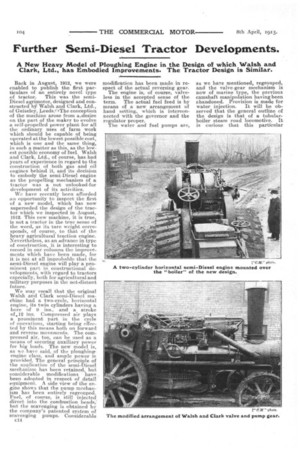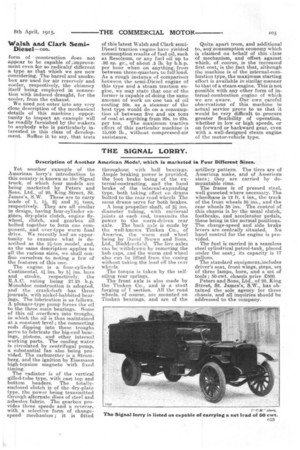Further Semi Diesel Tractor Developments.
Page 4

Page 5

If you've noticed an error in this article please click here to report it so we can fix it.
A New Heavy Model of Ploughing Engine in the Design of which Walsh and Clark, Ltd., has Embodied Improvements. The Tractor Design is Similar.
Back in August, 1912, we were enabled to publish the first particulars of an entirely novel type
of tractor. This was the semiDiesel agrimotor, designed and constructed 10 Walsh and Clark, Ltd., of Guiseley, Leeds.,-t The conception of the machine arose from a,desire on the part of the maker to evolve a self-propelled power plant for all the ordinary uses of farm work -which should be capable of being operated at the lowest possible cost, which is one and the same thing, in such a matter as this, as the lowest possible economy of fuel. Walsh and Clark, Ltd., of course, has had years of experience in regard to the construction of both gas and oil engines behind it, and its decision to embody the semi-Diesel engine as the propelling mechanism of a tractor was a not unlocked-for development of its activities.
We have recently been afforded an opportunity to inspect the first of a new model, which has now superseded the design of the tractor which we inspected in August, 1912. This new machine, it is true, is not a tractor in the true sense of the word, as its tare weight corresponds, of course, to that of the heavy agricultural traction engine. Nevertheless, as an advance in type of construction, it is interesting to record in our columns the improvements which have been made, for it is not at all improbable that the semi-Diesel engine will play a prominent part. M constructional developments, with regard to tractors especially, both for agricultural and military purposes in the not-distant future.
We may recall that the original Walsh and Clark semi-Diesel machine had a. two-cycle, horizontal engine, its twin cylinders having a bore. of 9 ins., and a. stroke 0%1.2 ins. Compressed air plays a prominent part in the cycle of operations, starting being effected by this means both on forward and reverse movements. The compressed air, too, can be used as a. means of securing auxiliary power for big loads. The new model is, as we have said, of the ploughing, -engine class, and ample power is provided. The general principle of the application of the semi-Diesel mechanism has been retained, but considerable modifications have been adopted in respect of detail equipment.. A side view of the engine shows that the pump mechanism has been entirely regrouped. Fuel, of course, is still injected direct into the combustion heads,: but the scavenging is obtained by the company's patented system of scavenging pumps. Considerable
c1.4 modification has been made in respect of the actual reversing gear.
The engine is, of course, valveless in the accepted sense of the term. The actual fuel feed is by means of a new arrangement of hand setting, which is interconnected with the governor and the regulator proper.
The water and fuel pumps are, as we have mentioned, regrouped, and the valve-gear mechanism is now of marine type, the previous camshaft manipulation having been abandoned. Provision is made for
water injection. It will be observed that the general outline of the design is that of a tubularboiler steam road locomotive. It is curious that this particular form of construction does not appear to be capable of ,:improvement even for so radicaliy different a type as that which we are now considering. The barrel and smokebox are used for air reservoir and cooler' respectively, the chimney itself being employed in connection with induced draught, for the cooler, from the exhaust.
We need not enter into any very close description of the mechanical details of this machine; opportunity to inspect an example will be readily furnished by the makers to anybody who is particularly interested in this class of development. Suffice it to say, that tests of this latest Walsh and Clark semiDiesel traction engine have yielded consumption results of fuel oil, such as Resoleum, or any fuel oil up to .92 sp. gr., of about .5 lb. by b.h.p. per hour when on anything from between three-quarters to full load. As a rough instance of comparison between the semi-Diesel engine of this type and a steam traction engine, we may state that one of the former is capable of doing the same amount of work on one ten of oil costing 50s. as a steamer of the best type would do on a consumption of between five and six tons of coal at anything from 20s, to 23s. per ton. The maximum tractive effort of this particular machine is 15,000 lb., without compressed-air assistance.
Quite apart trom, and additional to, any, consumption economy which is claimed on behalf of this class of mechanism, and offset, against which, of course, is the increased first cost, is the fact that, although the machine is of the internal-combustion type, the maximum starting effort is available in similar manner to that of a steam engine. This is not possible with any other form of internal-combustion engine of which we are aware. Our own careful observations of this machine in actual service prove to us that it would be very difficult to procure greater flexibility of operation, whether in low or high speeds, or on forward or backward gear, even with a well-designed steam engine of the motor-vehicle type.




















